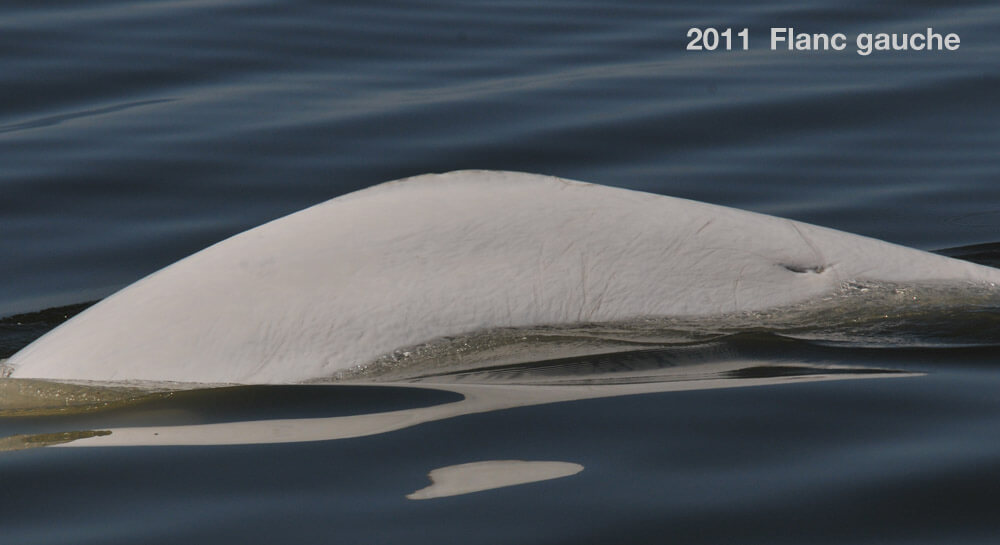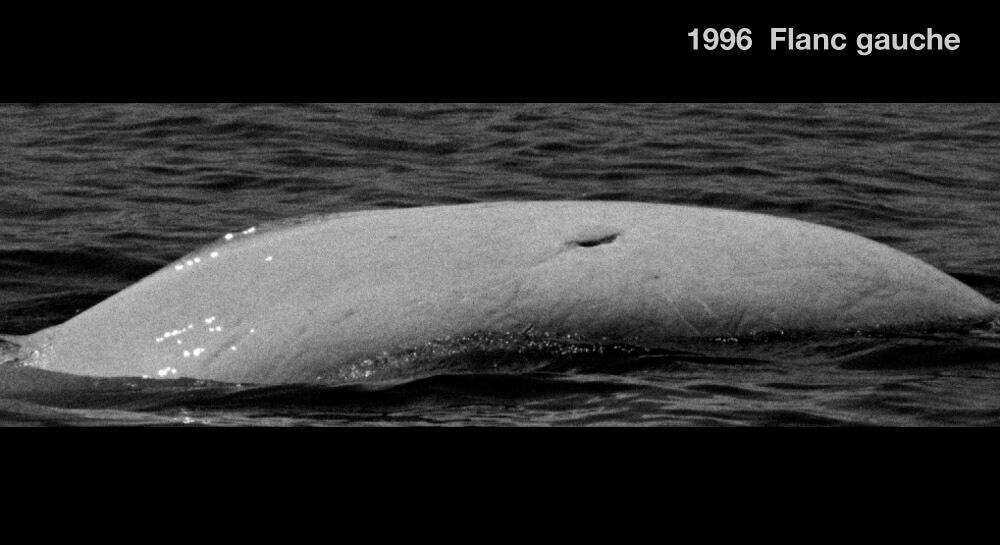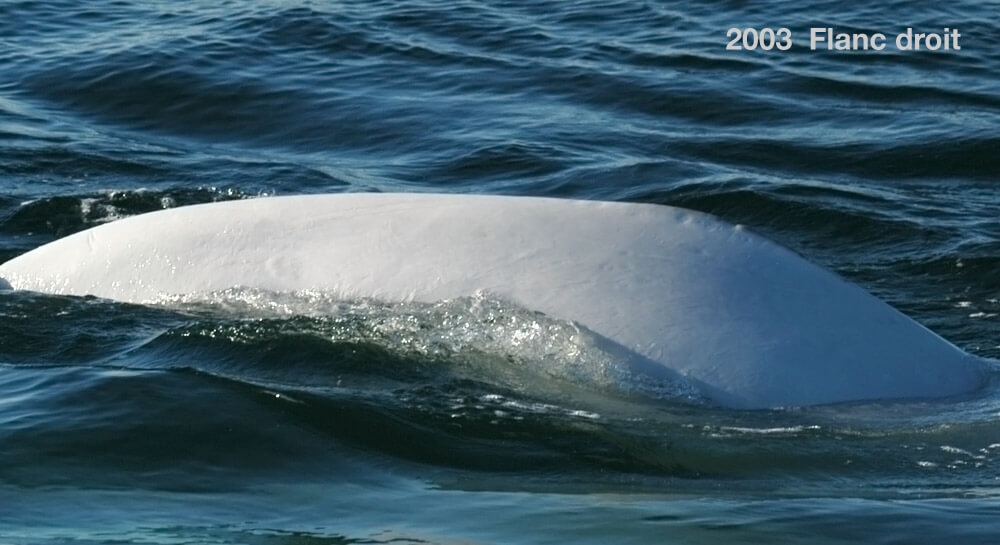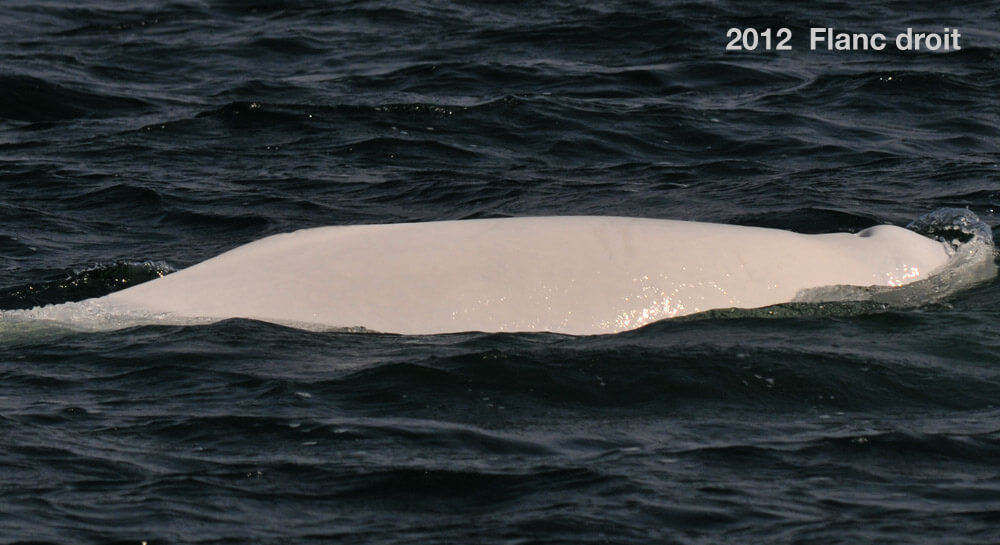Marjo
Beluga


Adopted by physicians at the 10th CSSS de la Haute-Côte-Nord-Manicouagan Regional Medical Congress on Emergency Medicine
-
ID number
DL0512
-
Sex
Presumed female
-
Year of birth
Around 1985
-
Known Since
1994
Distinctive traits
It is easier to identify Marjo from her left side thanks to the scar on her peduncle resembling a pair of eyeglasses. To confirm her identity from the right, one must carefully study the details of her dorsal crest.
Life story
Our first encounter with Marjo goes back to 1994, at which time she was gray. She turned entirely white around 2000. Belugas fade from gray to white in colour between the ages of 12 and 16. Marjo would therefore have been born in the mid-1980s, around the same time our beluga research project was initiated.
Her small size, habits and regular presence in herds comprising adults and young suggested that Marjo was a female belonging to the Saguenay community. In their summer range, females form large communities in which they tend to newborns and young. These communities are faithful to traditional territories and exchanges between them are uncommon. The presence of a newborn at Marjo’s sides in 2014 confirmed her sex.
In 2001 and 2002, she had also been seen with a young gray individual, possibly a calf that she had borne the year before. At birth, calves have brown skin. Later, they turn bluish gray and remain this colour until they’re about two years old. Juveniles aged 2 and up have gray skin, which then fades to white when they reach adulthood.
How Marjo’s story unfolds will help us better understand the social and reproductive lives of St. Lawrence belugas. By better understanding how belugas live, we will better be able to protect them.
Observations history in the Estuary
Years in which the animal was not observed Years in which the animal was observed
Latest news
Special day aboard the Bleuvet… Our research boat is host to guest researcher Valeria Vergara from the organization Ocean Wise, who has collaborated with the GREMM every summer since 2015. The team is also accompanied by a film crew that is putting together a documentary on beluga research. To kick off the day, we enter the Saguenay River. In the distance, we spot a herd of 30 to 40 individuals coming out of Baie Sainte-Marguerite. On the other side of the river, near Anse Saint-Etienne, there is another herd of 40 to 60 belugas. We photograph the groups before taking out the drone. By the time we’re ready to launch, the belugas are gone. We spot a new group. While photographing the animals and flying over them with the drone to document their behaviour, we recognize Marjo and Pure Laine. Meanwhile, Valeria records underwater communication using a hydrophone. Will we be able to recognize your beluga in our videos and sound recordings?
Summer 2016, our 32nd season at sea with the belugas, was once again rich in encounters and surprises. The good news is that, after a noticeable absence last year, we saw Marjo twice again this summer. Since our first meeting with Marjo in 1994, she has regularly been “missing in action”. We’re still trying to better understand these brief absences : do they reflect her travels or the vagaries of our sampling?
On July 5, 2016, we were off Anse à la Boule in the Saguenay when we spotted Marjo in a herd of around twenty individuals. The herd is made up of adults and juveniles. Marjo is swimming with Yogi and DL9018, two of her companions from the Saguenay community of females. Alongside Marjo, we notice the presence of a gray juvenile. However, this observation does not allow us to confirm whether it is indeed her youngster. At the time of our encounter, the herd was not very active, moving very slowly up the Saguenay Fjord. The animals are scattered and alone. After an hour’s observation, they come together in four groups. Finally, the herd ends its journey, not at the usual terminus of Baie Sainte-Marguerite, but at Anse Sainte-Étienne, where they’ll be “strolling” for the next few hours. Perhaps they’ve stumbled across a tantalizing shoal of prey!
Le Bleuvet’s field team had not yet entered its 32nd season when a GREMM research assistant, aboard a cruise ship for the photo-identification program for great whales off Tadoussac Bay, snapped some shots of Marjo. She was swimming in the company of eight belugas, including adults and calves. The herd was very active. The research assistant observed several tails out of the water, and the animals headed rapidly towards the Saguenay Fjord.
We’re at the Tadoussac marina to make a minor repair on our boat. One of the captains tells us that earlier he saw a group of belugas raising a bit of a ruckus near Buoy K54 at the mouth of the Saguenay. We decide to head to the scene. We discover nearly a dozen males badgering Marjo. A brouhaha on the surface ensues, bodies rubbing up against and rolling over one another. We can even see their pink erect penises. Cooperation amongst males to reproduce with Marjo? Sexual play? Difficult to say, as such behaviour has rarely been documented and is poorly known. Seemingly completely exasperated, Marjo periodically attempts to separate from the group. The bulls catch up to her in no time and the pestering resumes. Her calf, seen the day before with her, is absent.
The scene observed that day raises questions on belugas’ reproductive strategies. In both dolphins and chimpanzees, groups of males are known to practise infanticide so that the females become available to reproduce again more quickly. Might this same strategy be shared by belugas?
At the mouth of the Saguenay, we encounter a herd of 10 belugas. We immediately recognize Yogi, a female we’ve been following for decades. Beside her is a newborn calf. Is it hers? After fifteen minutes, the newborn joins the flank of another individual. After a while, it returns to Yogi, and repeats the process a few times. A group of four approaches. Among them we recognize Marjo and female DL1508. A second newborn is observed in the herd. Suddenly, the animals begin to swim rapidly upstream.





